This chapter discusses employer resistance to unionization and strategies used to maintain union-free work environments. It provides historical context on employer opposition dating back to the late 1800s. Key rationales for employer opposition include unions introducing higher wages and inflexible work rules that can decrease profitability and shareholder value. The chapter also outlines "union-free" approaches some employers use to avoid unionization in their operations, including explicit desires to remain non-union.
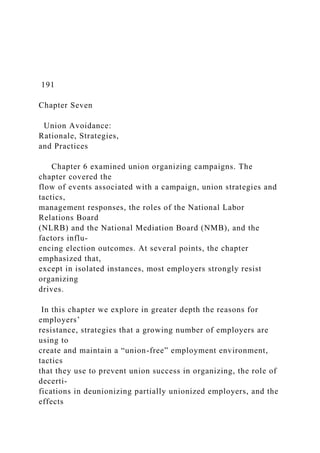














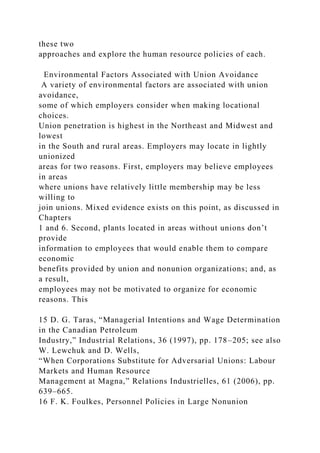



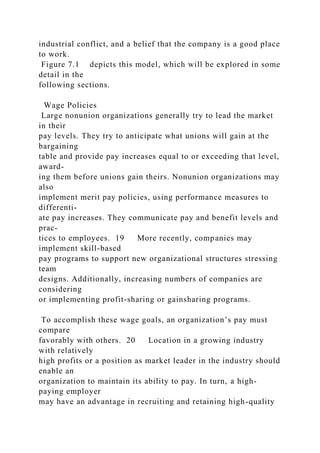
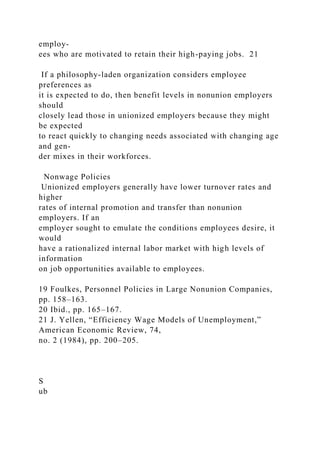










































![filed
the complaint. Exhibit 7.1 is a commentary on how one of
these systems
works.
28 A. O. Hirschman, Exit, Voice, and Loyalty (Cambridge, MA:
Harvard University Press, 1970).
29 For an overview, see R. Bernbeim, Nonunion Complaint
Systems: A Corporate Appraisal
(New York: Conference Board, 1980).
THE OPEN-DOOR POLICY
The Open-Door Policy is deeply ingrained in [the
company’s] history. This policy is a reflection of
our belief in respect for the individual. It is also
based on the principle that every person has a
right to appeal the actions of those who are
immediately over him in authority. It provides a
procedure for assuring fair and individual treat-
ment for every employee.
Should you have a problem which you believe
the company can help solve, discuss it with your
immediate manager or your location’s person-
nel manager or, in the field, with the manager
of your location. You will find that a frank talk
with your manager is usually the easiest and
most effective way to deal with the problem.
Second, if the matter is still not resolved, or is
of such a nature you prefer not to discuss it with
your immediate manager or location person-
nel manager, you should go to your local gen-
eral manager, regional manager, president or
general manager of your division or subsidiary,
whichever is appropriate.](https://image.slidesharecdn.com/191chaptersevenunionavoidancerationalestrat-221030035341-a73df6e4/85/191Chapter-Seven-Union-Avoidance-Rationale-Strat-docx-64-320.jpg)
















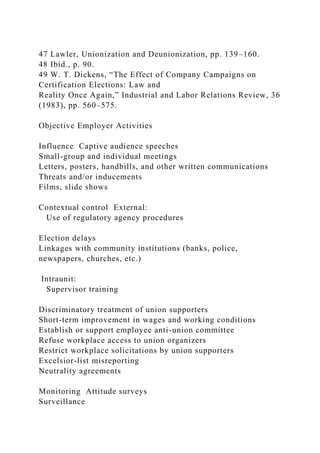

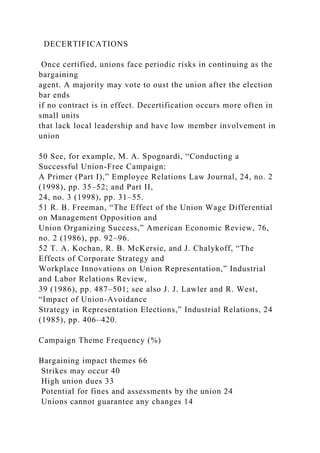









![]
/NeverEmbed [ true
]
/AntiAliasColorImages false
/CropColorImages true
/ColorImageMinResolution 300
/ColorImageMinResolutionPolicy /OK
/DownsampleColorImages false
/ColorImageDownsampleType /Bicubic
/ColorImageResolution 300
/ColorImageDepth 8
/ColorImageMinDownsampleDepth 1
/ColorImageDownsampleThreshold 1.50000
/EncodeColorImages true
/ColorImageFilter /FlateEncode
/AutoFilterColorImages false
/ColorImageAutoFilterStrategy /JPEG
/ColorACSImageDict <<
/QFactor 0.15
/HSamples [1 1 1 1] /VSamples [1 1 1 1]
>>
/ColorImageDict <<
/QFactor 0.15
/HSamples [1 1 1 1] /VSamples [1 1 1 1]
>>
/JPEG2000ColorACSImageDict <<
/TileWidth 256
/TileHeight 256
/Quality 30
>>
/JPEG2000ColorImageDict <<
/TileWidth 256
/TileHeight 256
/Quality 30
>>
/AntiAliasGrayImages false](https://image.slidesharecdn.com/191chaptersevenunionavoidancerationalestrat-221030035341-a73df6e4/85/191Chapter-Seven-Union-Avoidance-Rationale-Strat-docx-93-320.jpg)
![/CropGrayImages true
/GrayImageMinResolution 300
/GrayImageMinResolutionPolicy /OK
/DownsampleGrayImages false
/GrayImageDownsampleType /Bicubic
/GrayImageResolution 300
/GrayImageDepth 8
/GrayImageMinDownsampleDepth 2
/GrayImageDownsampleThreshold 1.50000
/EncodeGrayImages true
/GrayImageFilter /FlateEncode
/AutoFilterGrayImages false
/GrayImageAutoFilterStrategy /JPEG
/GrayACSImageDict <<
/QFactor 0.15
/HSamples [1 1 1 1] /VSamples [1 1 1 1]
>>
/GrayImageDict <<
/QFactor 0.15
/HSamples [1 1 1 1] /VSamples [1 1 1 1]
>>
/JPEG2000GrayACSImageDict <<
/TileWidth 256
/TileHeight 256
/Quality 30
>>
/JPEG2000GrayImageDict <<
/TileWidth 256
/TileHeight 256
/Quality 30
>>
/AntiAliasMonoImages false
/CropMonoImages true
/MonoImageMinResolution 1200
/MonoImageMinResolutionPolicy /OK
/DownsampleMonoImages false](https://image.slidesharecdn.com/191chaptersevenunionavoidancerationalestrat-221030035341-a73df6e4/85/191Chapter-Seven-Union-Avoidance-Rationale-Strat-docx-94-320.jpg)
![/MonoImageDownsampleType /Bicubic
/MonoImageResolution 1200
/MonoImageDepth -1
/MonoImageDownsampleThreshold 1.50000
/EncodeMonoImages true
/MonoImageFilter /CCITTFaxEncode
/MonoImageDict <<
/K -1
>>
/AllowPSXObjects false
/CheckCompliance [
/None
]
/PDFX1aCheck false
/PDFX3Check false
/PDFXCompliantPDFOnly false
/PDFXNoTrimBoxError true
/PDFXTrimBoxToMediaBoxOffset [
0.00000
0.00000
0.00000
0.00000
]
/PDFXSetBleedBoxToMediaBox true
/PDFXBleedBoxToTrimBoxOffset [
0.00000
0.00000
0.00000
0.00000
]
/PDFXOutputIntentProfile (None)
/PDFXOutputConditionIdentifier ()
/PDFXOutputCondition ()
/PDFXRegistryName ()
/PDFXTrapped /False](https://image.slidesharecdn.com/191chaptersevenunionavoidancerationalestrat-221030035341-a73df6e4/85/191Chapter-Seven-Union-Avoidance-Rationale-Strat-docx-95-320.jpg)






![(Adobe)
(Common)
(1.0)
]
/OtherNamespaces [
<<
/AsReaderSpreads false
/CropImagesToFrames true
/ErrorControl /WarnAndContinue
/FlattenerIgnoreSpreadOverrides false
/IncludeGuidesGrids false
/IncludeNonPrinting false
/IncludeSlug false
/Namespace [
(Adobe)
(InDesign)
(4.0)
]
/OmitPlacedBitmaps false
/OmitPlacedEPS false
/OmitPlacedPDF false
/SimulateOverprint /Legacy
>>
<<
/AddBleedMarks false
/AddColorBars false
/AddCropMarks false
/AddPageInfo false
/AddRegMarks false
/ConvertColors /NoConversion
/DestinationProfileName ()
/DestinationProfileSelector /NA
/Downsample16BitImages true
/FlattenerPreset <<
/PresetSelector /MediumResolution
>>](https://image.slidesharecdn.com/191chaptersevenunionavoidancerationalestrat-221030035341-a73df6e4/85/191Chapter-Seven-Union-Avoidance-Rationale-Strat-docx-102-320.jpg)
![/FormElements false
/GenerateStructure true
/IncludeBookmarks false
/IncludeHyperlinks false
/IncludeInteractive false
/IncludeLayers false
/IncludeProfiles true
/MultimediaHandling /UseObjectSettings
/Namespace [
(Adobe)
(CreativeSuite)
(2.0)
]
/PDFXOutputIntentProfileSelector /NA
/PreserveEditing true
/UntaggedCMYKHandling /LeaveUntagged
/UntaggedRGBHandling /LeaveUntagged
/UseDocumentBleed false
>>
]
>> setdistillerparams
<<
/HWResolution [2400 2400]
/PageSize [612.000 792.000]
>> setpagedevice
152
Chapter Six
Union Organizing
Campaigns](https://image.slidesharecdn.com/191chaptersevenunionavoidancerationalestrat-221030035341-a73df6e4/85/191Chapter-Seven-Union-Avoidance-Rationale-Strat-docx-103-320.jpg)

























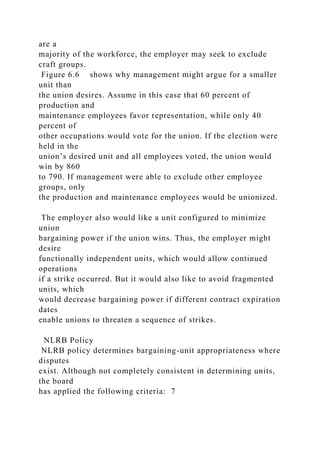







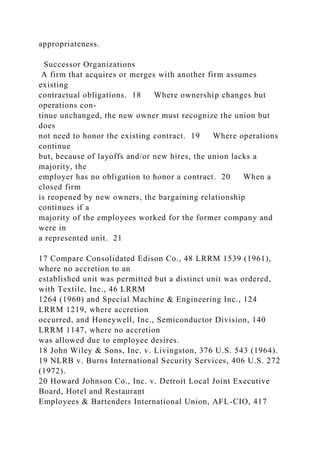




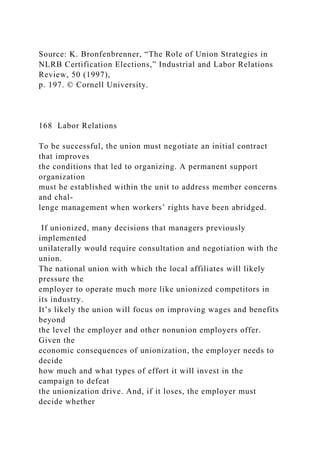
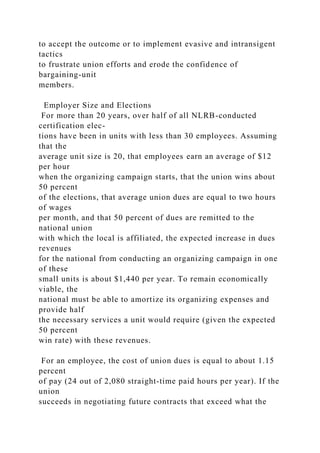






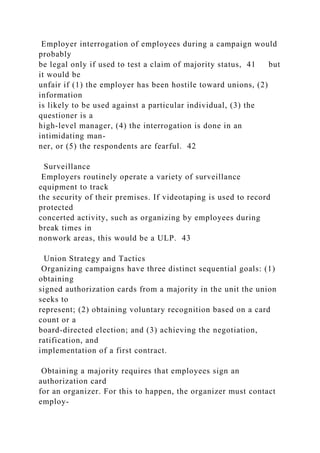















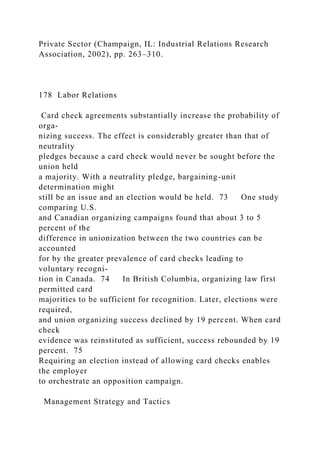








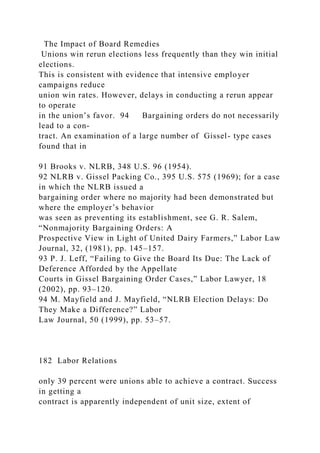

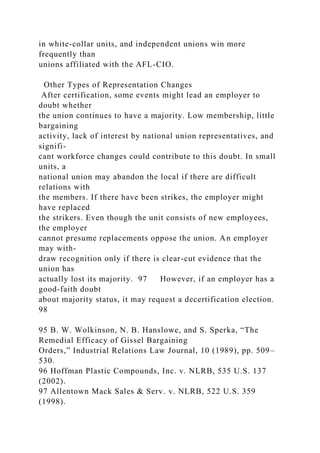









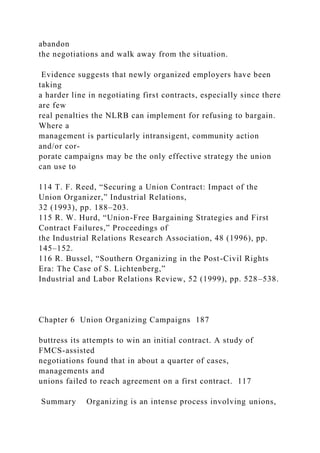








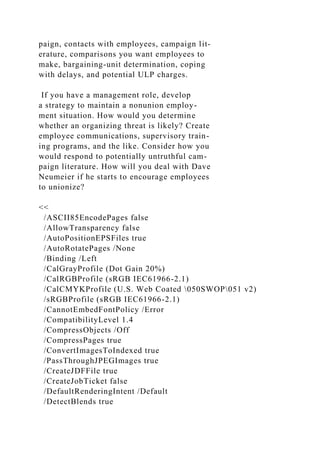
![/DetectCurves 0.1000
/ColorConversionStrategy /LeaveColorUnchanged
/DoThumbnails true
/EmbedAllFonts true
/EmbedOpenType false
/ParseICCProfilesInComments true
/EmbedJobOptions true
/DSCReportingLevel 0
/EmitDSCWarnings false
/EndPage -1
/ImageMemory 1048576
/LockDistillerParams true
/MaxSubsetPct 100
/Optimize false
/OPM 1
/ParseDSCComments true
/ParseDSCCommentsForDocInfo true
/PreserveCopyPage true
/PreserveDICMYKValues true
/PreserveEPSInfo true
/PreserveFlatness true
/PreserveHalftoneInfo false
/PreserveOPIComments false
/PreserveOverprintSettings true
/StartPage 1
/SubsetFonts true
/TransferFunctionInfo /Remove
/UCRandBGInfo /Preserve
/UsePrologue false
/ColorSettingsFile ()
/AlwaysEmbed [ true
]
/NeverEmbed [ true
]
/AntiAliasColorImages false
/CropColorImages true](https://image.slidesharecdn.com/191chaptersevenunionavoidancerationalestrat-221030035341-a73df6e4/85/191Chapter-Seven-Union-Avoidance-Rationale-Strat-docx-197-320.jpg)
![/ColorImageMinResolution 300
/ColorImageMinResolutionPolicy /OK
/DownsampleColorImages false
/ColorImageDownsampleType /Bicubic
/ColorImageResolution 300
/ColorImageDepth 8
/ColorImageMinDownsampleDepth 1
/ColorImageDownsampleThreshold 1.50000
/EncodeColorImages true
/ColorImageFilter /FlateEncode
/AutoFilterColorImages false
/ColorImageAutoFilterStrategy /JPEG
/ColorACSImageDict <<
/QFactor 0.15
/HSamples [1 1 1 1] /VSamples [1 1 1 1]
>>
/ColorImageDict <<
/QFactor 0.15
/HSamples [1 1 1 1] /VSamples [1 1 1 1]
>>
/JPEG2000ColorACSImageDict <<
/TileWidth 256
/TileHeight 256
/Quality 30
>>
/JPEG2000ColorImageDict <<
/TileWidth 256
/TileHeight 256
/Quality 30
>>
/AntiAliasGrayImages false
/CropGrayImages true
/GrayImageMinResolution 300
/GrayImageMinResolutionPolicy /OK
/DownsampleGrayImages false
/GrayImageDownsampleType /Bicubic](https://image.slidesharecdn.com/191chaptersevenunionavoidancerationalestrat-221030035341-a73df6e4/85/191Chapter-Seven-Union-Avoidance-Rationale-Strat-docx-198-320.jpg)
![/GrayImageResolution 300
/GrayImageDepth 8
/GrayImageMinDownsampleDepth 2
/GrayImageDownsampleThreshold 1.50000
/EncodeGrayImages true
/GrayImageFilter /FlateEncode
/AutoFilterGrayImages false
/GrayImageAutoFilterStrategy /JPEG
/GrayACSImageDict <<
/QFactor 0.15
/HSamples [1 1 1 1] /VSamples [1 1 1 1]
>>
/GrayImageDict <<
/QFactor 0.15
/HSamples [1 1 1 1] /VSamples [1 1 1 1]
>>
/JPEG2000GrayACSImageDict <<
/TileWidth 256
/TileHeight 256
/Quality 30
>>
/JPEG2000GrayImageDict <<
/TileWidth 256
/TileHeight 256
/Quality 30
>>
/AntiAliasMonoImages false
/CropMonoImages true
/MonoImageMinResolution 1200
/MonoImageMinResolutionPolicy /OK
/DownsampleMonoImages false
/MonoImageDownsampleType /Bicubic
/MonoImageResolution 1200
/MonoImageDepth -1
/MonoImageDownsampleThreshold 1.50000
/EncodeMonoImages true](https://image.slidesharecdn.com/191chaptersevenunionavoidancerationalestrat-221030035341-a73df6e4/85/191Chapter-Seven-Union-Avoidance-Rationale-Strat-docx-199-320.jpg)
![/MonoImageFilter /CCITTFaxEncode
/MonoImageDict <<
/K -1
>>
/AllowPSXObjects false
/CheckCompliance [
/None
]
/PDFX1aCheck false
/PDFX3Check false
/PDFXCompliantPDFOnly false
/PDFXNoTrimBoxError true
/PDFXTrimBoxToMediaBoxOffset [
0.00000
0.00000
0.00000
0.00000
]
/PDFXSetBleedBoxToMediaBox true
/PDFXBleedBoxToTrimBoxOffset [
0.00000
0.00000
0.00000
0.00000
]
/PDFXOutputIntentProfile (None)
/PDFXOutputConditionIdentifier ()
/PDFXOutputCondition ()
/PDFXRegistryName ()
/PDFXTrapped /False
/Description <<
/CHS
<FEFF4f7f75288fd94e9b8bbe5b9a521b5efa76840020005000440
04600206587686353ef901a8fc7684c976262535370673a548c002
000700072006f006f00660065007200208fdb884c9ad88d2891cf6](https://image.slidesharecdn.com/191chaptersevenunionavoidancerationalestrat-221030035341-a73df6e4/85/191Chapter-Seven-Union-Avoidance-Rationale-Strat-docx-200-320.jpg)



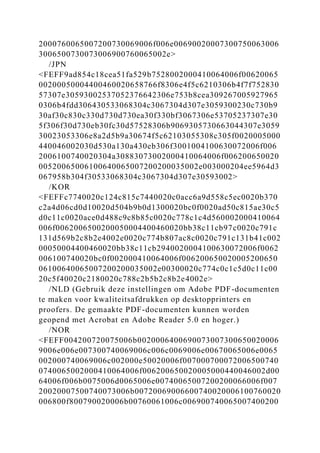

![064006f0073007400750073007400610020007600610072007400
65006e002e00200020004c0075006f00640075007400200050004
40046002d0064006f006b0075006d0065006e0074006900740020
0076006f0069006400610061006e0020006100760061007400610
020004100630072006f0062006100740069006c006c0061002000
6a0061002000410064006f0062006500200052006500610064006
5007200200035002e0030003a006c006c00610020006a00610020
0075007500640065006d006d0069006c006c0061002e>
/SVE
<FEFF0041006e007600e4006e00640020006400650020006800e
4007200200069006e0073007400e4006c006c006e0069006e0067
00610072006e00610020006f006d0020006400750020007600690
06c006c00200073006b006100700061002000410064006f006200
650020005000440046002d0064006f006b0075006d0065006e007
40020006600f600720020006b00760061006c0069007400650074
0073007500740073006b007200690066007400650072002000700
0e5002000760061006e006c00690067006100200073006b007200
6900760061007200650020006f006300680020006600f60072002
0006b006f007200720065006b007400750072002e002000200053
006b006100700061006400650020005000440046002d0064006f0
06b0075006d0065006e00740020006b0061006e002000f6007000
70006e00610073002000690020004100630072006f00620061007
40020006f00630068002000410064006f00620065002000520065
006100640065007200200035002e00300020006f0063006800200
0730065006e006100720065002e>
/ENU (Use these settings to create Adobe PDF documents for
submission to RR Donnelley Book plants. Created PDF
documents can be opened with Acrobat and Adobe Reader 5.0
and later.)
>>
/Namespace [
(Adobe)
(Common)
(1.0)
]
/OtherNamespaces [](https://image.slidesharecdn.com/191chaptersevenunionavoidancerationalestrat-221030035341-a73df6e4/85/191Chapter-Seven-Union-Avoidance-Rationale-Strat-docx-206-320.jpg)
![<<
/AsReaderSpreads false
/CropImagesToFrames true
/ErrorControl /WarnAndContinue
/FlattenerIgnoreSpreadOverrides false
/IncludeGuidesGrids false
/IncludeNonPrinting false
/IncludeSlug false
/Namespace [
(Adobe)
(InDesign)
(4.0)
]
/OmitPlacedBitmaps false
/OmitPlacedEPS false
/OmitPlacedPDF false
/SimulateOverprint /Legacy
>>
<<
/AddBleedMarks false
/AddColorBars false
/AddCropMarks false
/AddPageInfo false
/AddRegMarks false
/ConvertColors /NoConversion
/DestinationProfileName ()
/DestinationProfileSelector /NA
/Downsample16BitImages true
/FlattenerPreset <<
/PresetSelector /MediumResolution
>>
/FormElements false
/GenerateStructure true
/IncludeBookmarks false
/IncludeHyperlinks false
/IncludeInteractive false](https://image.slidesharecdn.com/191chaptersevenunionavoidancerationalestrat-221030035341-a73df6e4/85/191Chapter-Seven-Union-Avoidance-Rationale-Strat-docx-207-320.jpg)
![/IncludeLayers false
/IncludeProfiles true
/MultimediaHandling /UseObjectSettings
/Namespace [
(Adobe)
(CreativeSuite)
(2.0)
]
/PDFXOutputIntentProfileSelector /NA
/PreserveEditing true
/UntaggedCMYKHandling /LeaveUntagged
/UntaggedRGBHandling /LeaveUntagged
/UseDocumentBleed false
>>
]
>> setdistillerparams
<<
/HWResolution [2400 2400]
/PageSize [612.000 792.000]
>> setpagedevice](https://image.slidesharecdn.com/191chaptersevenunionavoidancerationalestrat-221030035341-a73df6e4/85/191Chapter-Seven-Union-Avoidance-Rationale-Strat-docx-208-320.jpg)